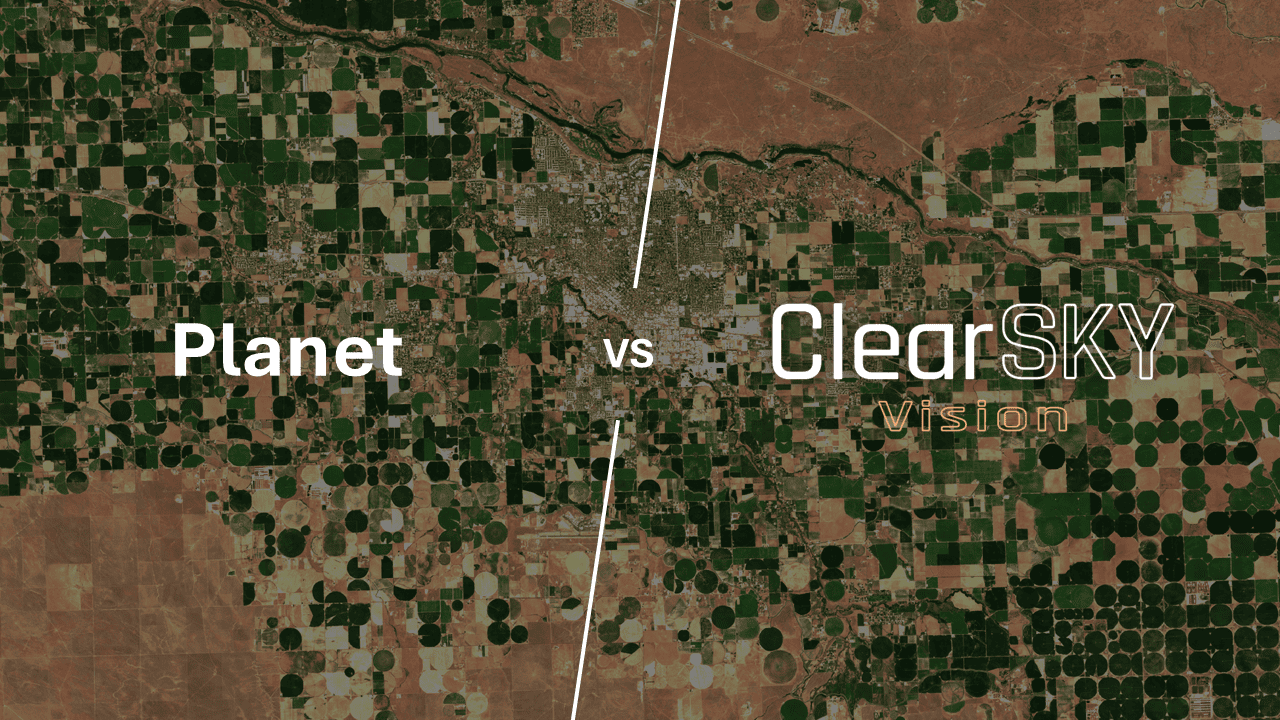ClearSKY vs AlphaEarth (and Sentinel-2): Which Fits Your Monitoring Goal?
2025-08-21 · 5 min read · ClearSKY · AlphaEarth · Data Fusion

TL;DR: ClearSKY vs AlphaEarth comes down to date faithfulness and latency. ClearSKY fuses SAR + optical across same day and nearby prior days to deliver a date-specific view in near real time, never using future data. AlphaEarth produces globally consistent, model-derived layers that emphasise coverage and uniformity rather than single-date snapshots. Sentinel-2 remains the free, science-grade baseline.
Why this comparison matters
Many teams search for “Sentinel-2 vs AlphaEarth” or “ClearSKY vs AlphaEarth” when they are deciding between date-specific monitoring and globally consistent layers. These approaches solve different problems. If you need an observation that represents a particular day, time matters more than a perfectly uniform map. If you need a gap-free, consistent layer for large-area analysis, uniformity matters more than strict per-day fidelity.
ClearSKY vs AlphaEarth at a glance
ClearSKY: date-faithful, SAR-powered fusion
- What it is. A fusion service that combines multiple satellites and multiple sensors (SAR + optical), prioritising same-day observations and, where needed, nearby prior days to reconstruct a surface view for a specific date. No future data is used.
- Where it shines. Near real time operations, daily change detection, incident response, agricultural and forestry decisions, compliance checks that must reference a date.
- Why it’s different. SAR penetrates cloud and provides structure when optical is obscured. Multi-constellation intake raises the odds of getting usable signal on the day you care about.
AlphaEarth: globally consistent, model-derived layers
- What it is. A geospatial AI that learns from many sources to produce consistent, gap-minimised layers and analytics across regions and seasons.
- Where it shines. Thematic mapping at scale, screening and prioritisation, research workflows that need uniform inputs, long-term context when exact acquisition times are less important.
- Why it’s different. Outputs are model-derived, optimised for spatial and temporal consistency rather than strict single-date observations or rapid delivery.
Key differences that affect decisions
Temporal consistency and date faithfulness
- ClearSKY: builds a date-specific product. Same-day data first, then nearby prior days only if needed. The result reflects conditions for a particular date.
- AlphaEarth: provides consistent layers that are not tied to a single acquisition time. Excellent for completeness and uniformity, not for audit to a specific day.
Latency and operational use
- ClearSKY: designed for near real time monitoring and decisions made on daily or sub-daily cycles.
- AlphaEarth: designed for coherent, ready-to-use layers with an emphasis on coverage and stability rather than immediate availability.
Sensors and cloud handling
- ClearSKY: fuses SAR + optical to recover information under cloud, then blends multi-constellation inputs to improve coverage without long seasonal windows.
- AlphaEarth: integrates many data sources into a learned representation that improves uniformity but does not guarantee a per-day snapshot.
Where Sentinel-2 fits
Sentinel-2 is the open, science-grade baseline. It offers 13 optical bands at 10–60 m and powers countless indices and methods. On its own it is often cloudy and may require mosaicking or fusion. Many users rely on Sentinel-2 as a reference or as an ingredient in higher-level products.
Use cases: choose by outcome, not by brand
Pick ClearSKY when you need
- Daily change detection on assets, fields, harvest blocks, or water bodies.
- Near real time views for response and routing when weather is variable.
- Date-referenced evidence for checks and inspections.
- Cloud-robust monitoring using SAR + optical without waiting for a clear scene.
Pick AlphaEarth when you need
- Consistent layers for mapping and screening across countries or continents.
- Uniform inputs for modelling and research.
- Contextual baselines where exact acquisition time is less critical than coverage and coherence.
Keep Sentinel-2 in the toolkit when you need
- Free, open inputs for custom analysis or academic projects.
- Band-level control for specialised indices and experiments.
ClearSKY vs AlphaEarth: quick comparison
| Dimension | ClearSKY | AlphaEarth |
|---|---|---|
| Core idea | Fusion of SAR + optical across same day and nearby prior days | Model-derived globally consistent layers |
| Time fidelity | Date-specific product for a particular day | Not a single-date snapshot |
| Latency | Near real time for operations | Emphasis on coverage and uniformity |
| Cloud strategy | SAR plus multi-constellation optical to maintain coverage | Learned representation to fill gaps and smooth variability |
| Best for | Daily ops, change detection, inspections, response | Large-area mapping, screening, research inputs |
Sentinel-2, ClearSKY, AlphaEarth: side-by-side
| Feature | ClearSKY | AlphaEarth | Sentinel-2 |
|---|---|---|---|
| What you get | Date-specific fusion from SAR + optical with short nearby-days extension | Consistent, model-derived layers | Single optical scenes, often cloudy |
| Temporal focus | Date faithfulness | Consistency and coverage | Single acquisitions |
| Cost and access | Commercial service | Research/partnered platform | Open data |
| Typical use | Operations, compliance, daily monitoring | Mapping and analytics at scale | DIY processing, indices, experiments |
Which should you pick?
If your work depends on what happened on a given date, choose the approach that preserves that date and delivers quickly. If your work depends on a consistent picture across space and time, choose the approach that prioritises uniformity and coverage. Many teams use both: ClearSKY for the daily truth on the ground, AlphaEarth for the big-picture context, and Sentinel-2 as an open reference and research input.


